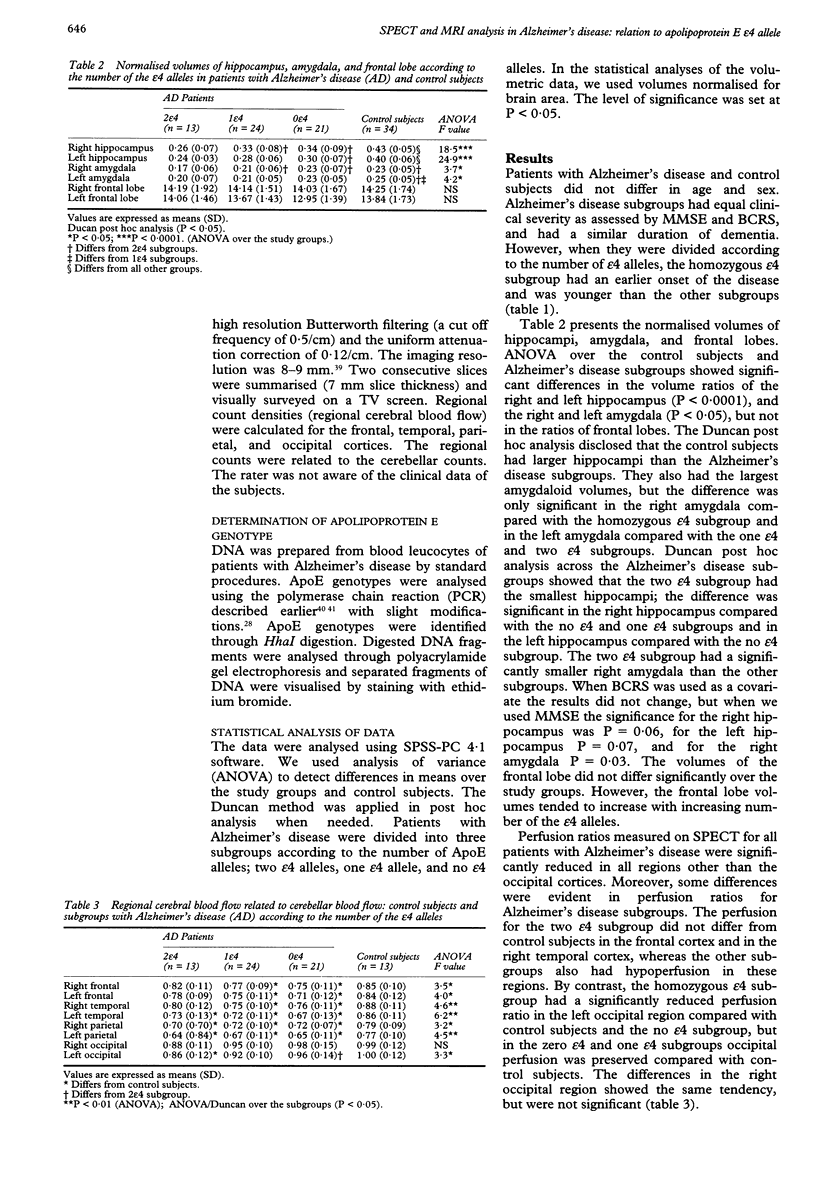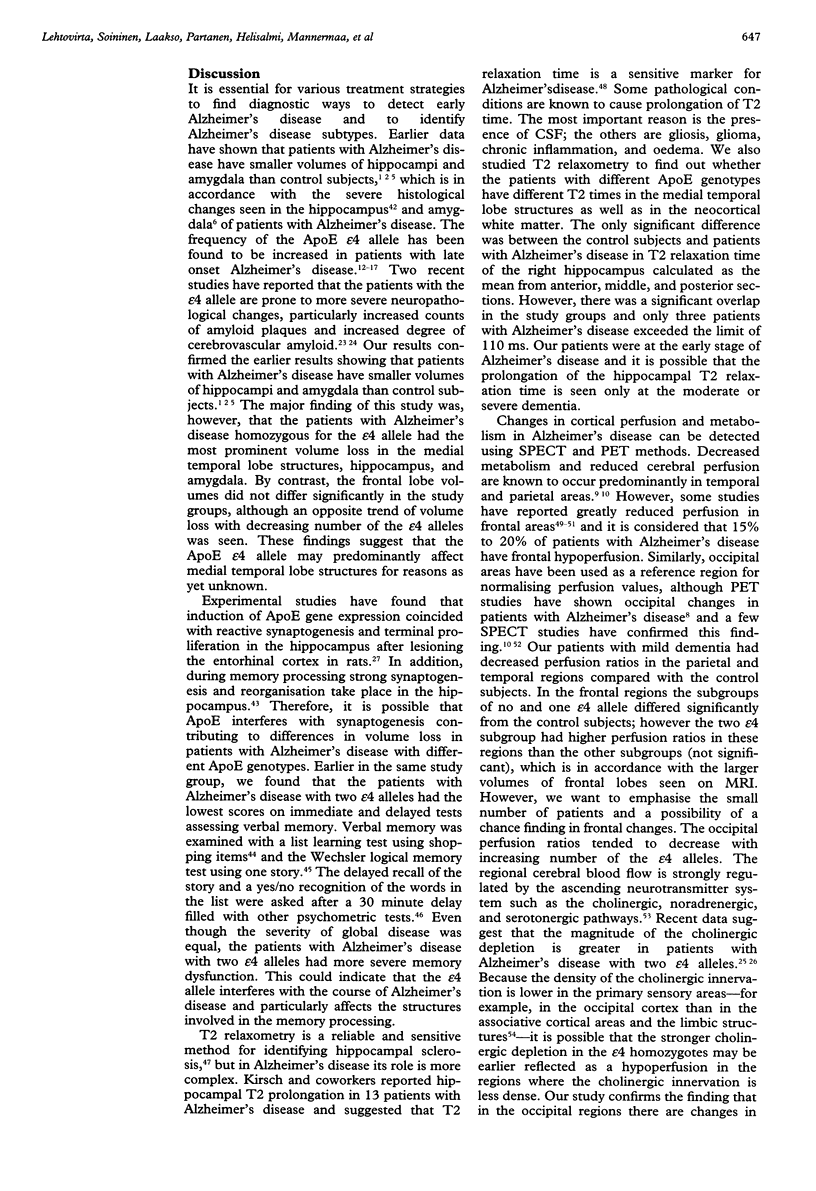Abstract
OBJECTIVES--The epsilon 4 allele of apolipoprotein E (ApoE) is a risk factor for late onset Alzheimer's disease. ApoE is present in senile plaques, neurofibrillary tangles, and cerebrovascular amyloid, and it is implicated in synaptogenesis. The effect of ApoE polymorphism on the volumes of hippocampus, amygdala, and frontal lobe was studied. The hypothesis was that the patients with Alzheimer's disease carrying the epsilon 4 allele have more pronounced atrophy. The relation of ApoE and cerebral blood flow on cortical areas was also assessed. METHODS--Fifty eight patients with Alzheimer's disease at the early stage of the disease and 34 control subjects were studied. Patients with Alzheimer's disease were divided into subgroups according to the number of the epsilon 4 alleles. Volumes were measured by MRI and regional cerebral blood flow ratios referred to the cerebellum were examined by 99mTc-HMPAO SPECT. ApoE genotypes were determined by digestion of ApoE polymerase chain reaction products with the restriction enzyme Hha1. RESULTS--patients with Alzheimer's disease had smaller volumes of hippocampi and amygdala compared with control subjects, and the patients with Alzheimer's disease homozygous for the epsilon 4 allele had the most prominent volume loss in the medial temporal lobe structures. The frontal lobe volumes did not differ significantly. All patients with Alzheimer's disease had bilateral temporoparietal hypoperfusion and the subgroups with one or no epsilon 4 alleles also had frontal hypoperfusion compared with control subjects. The occipital perfusion ratios tended to decrease with increasing number of epsilon 4 alleles. CONCLUSIONS--Patients with Alzheimer's disease homozygous for the epsilon 4 allele seem to have severe damage in the medial temporal lobe structures early in the disease process and differ from the patients with Alzheimer's disease with one or no epsilon 4 alleles.
Full text
PDF





Selected References
These references are in PubMed. This may not be the complete list of references from this article.
- Bliss T. V., Collingridge G. L. A synaptic model of memory: long-term potentiation in the hippocampus. Nature. 1993 Jan 7;361(6407):31–39. doi: 10.1038/361031a0. [DOI] [PubMed] [Google Scholar]
- Burns A., Philpot M. P., Costa D. C., Ell P. J., Levy R. The investigation of Alzheimer's disease with single photon emission tomography. J Neurol Neurosurg Psychiatry. 1989 Feb;52(2):248–253. doi: 10.1136/jnnp.52.2.248. [DOI] [PMC free article] [PubMed] [Google Scholar]
- Corder E. H., Saunders A. M., Strittmatter W. J., Schmechel D. E., Gaskell P. C., Small G. W., Roses A. D., Haines J. L., Pericak-Vance M. A. Gene dose of apolipoprotein E type 4 allele and the risk of Alzheimer's disease in late onset families. Science. 1993 Aug 13;261(5123):921–923. doi: 10.1126/science.8346443. [DOI] [PubMed] [Google Scholar]
- Cuénod C. A., Denys A., Michot J. L., Jehenson P., Forette F., Kaplan D., Syrota A., Boller F. Amygdala atrophy in Alzheimer's disease. An in vivo magnetic resonance imaging study. Arch Neurol. 1993 Sep;50(9):941–945. doi: 10.1001/archneur.1993.00540090046009. [DOI] [PubMed] [Google Scholar]
- Folstein M. F., Folstein S. E., McHugh P. R. "Mini-mental state". A practical method for grading the cognitive state of patients for the clinician. J Psychiatr Res. 1975 Nov;12(3):189–198. doi: 10.1016/0022-3956(75)90026-6. [DOI] [PubMed] [Google Scholar]
- Frisoni G. B., Pizzolato G., Bianchetti A., Chierichetti F., Ferlin G., Battistin L., Trabucchi M. Single photon emission computed tomography with [99Tc]-HM-PAO and [123I]-IBZM in Alzheimer's disease and dementia of frontal type: preliminary results. Acta Neurol Scand. 1994 Mar;89(3):199–203. doi: 10.1111/j.1600-0404.1994.tb01661.x. [DOI] [PubMed] [Google Scholar]
- HAMILTON M. A rating scale for depression. J Neurol Neurosurg Psychiatry. 1960 Feb;23:56–62. doi: 10.1136/jnnp.23.1.56. [DOI] [PMC free article] [PubMed] [Google Scholar]
- Hixson J. E., Vernier D. T. Restriction isotyping of human apolipoprotein E by gene amplification and cleavage with HhaI. J Lipid Res. 1990 Mar;31(3):545–548. [PubMed] [Google Scholar]
- Hyman B. T., Van Hoesen G. W., Damasio A. R., Barnes C. L. Alzheimer's disease: cell-specific pathology isolates the hippocampal formation. Science. 1984 Sep 14;225(4667):1168–1170. doi: 10.1126/science.6474172. [DOI] [PubMed] [Google Scholar]
- Jack C. R., Jr, Petersen R. C., O'Brien P. C., Tangalos E. G. MR-based hippocampal volumetry in the diagnosis of Alzheimer's disease. Neurology. 1992 Jan;42(1):183–188. doi: 10.1212/wnl.42.1.183. [DOI] [PubMed] [Google Scholar]
- Jackson G. D., Connelly A., Duncan J. S., Grünewald R. A., Gadian D. G. Detection of hippocampal pathology in intractable partial epilepsy: increased sensitivity with quantitative magnetic resonance T2 relaxometry. Neurology. 1993 Sep;43(9):1793–1799. doi: 10.1212/wnl.43.9.1793. [DOI] [PubMed] [Google Scholar]
- Johnson K. A., Mueller S. T., Walshe T. M., English R. J., Holman B. L. Cerebral perfusion imaging in Alzheimer's disease. Use of single photon emission computed tomography and iofetamine hydrochloride I 123. Arch Neurol. 1987 Feb;44(2):165–168. doi: 10.1001/archneur.1987.00520140035014. [DOI] [PubMed] [Google Scholar]
- Killiany R. J., Moss M. B., Albert M. S., Sandor T., Tieman J., Jolesz F. Temporal lobe regions on magnetic resonance imaging identify patients with early Alzheimer's disease. Arch Neurol. 1993 Sep;50(9):949–954. doi: 10.1001/archneur.1993.00540090052010. [DOI] [PubMed] [Google Scholar]
- Kirsch S. J., Jacobs R. W., Butcher L. L., Beatty J. Prolongation of magnetic resonance T2 time in hippocampus of human patients marks the presence and severity of Alzheimer's disease. Neurosci Lett. 1992 Jan 6;134(2):187–190. doi: 10.1016/0304-3940(92)90513-7. [DOI] [PubMed] [Google Scholar]
- Kuikka J. T., Tenhunen-Eskelinen M., Jurvelin J., Kiiliänen H. Physical performance of the Siemens MultiSPECT 3 gamma camera. Nucl Med Commun. 1993 Jun;14(6):490–497. doi: 10.1097/00006231-199306000-00013. [DOI] [PubMed] [Google Scholar]
- Kuusisto J., Koivisto K., Kervinen K., Mykkänen L., Helkala E. L., Vanhanen M., Hänninen T., Pyörälä K., Kesäniemi Y. A., Riekkinen P. Association of apolipoprotein E phenotypes with late onset Alzheimer's disease: population based study. BMJ. 1994 Sep 10;309(6955):636–638. doi: 10.1136/bmj.309.6955.636. [DOI] [PMC free article] [PubMed] [Google Scholar]
- Lehtovirta M., Helisalmi S., Mannermaa A., Soininen H., Koivisto K., Ryynänen M., Riekkinen P., Sr Apolipoprotein E polymorphism and Alzheimer's disease in eastern Finland. Neurosci Lett. 1995 Feb 6;185(1):13–15. doi: 10.1016/0304-3940(94)11213-3. [DOI] [PubMed] [Google Scholar]
- Lehtovirta M., Laakso M. P., Soininen H., Helisalmi S., Mannermaa A., Helkala E. L., Partanen K., Ryynänen M., Vainio P., Hartikainen P. Volumes of hippocampus, amygdala and frontal lobe in Alzheimer patients with different apolipoprotein E genotypes. Neuroscience. 1995 Jul;67(1):65–72. doi: 10.1016/0306-4522(95)00014-a. [DOI] [PubMed] [Google Scholar]
- Lehtovirta M., Soininen H., Helisalmi S., Mannermaa A., Helkala E. L., Hartikainen P., Hänninen T., Ryynänen M., Riekkinen P. J. Clinical and neuropsychological characteristics in familial and sporadic Alzheimer's disease: relation to apolipoprotein E polymorphism. Neurology. 1996 Feb;46(2):413–419. doi: 10.1212/wnl.46.2.413. [DOI] [PubMed] [Google Scholar]
- Mayeux R., Stern Y., Ottman R., Tatemichi T. K., Tang M. X., Maestre G., Ngai C., Tycko B., Ginsberg H. The apolipoprotein epsilon 4 allele in patients with Alzheimer's disease. Ann Neurol. 1993 Nov;34(5):752–754. doi: 10.1002/ana.410340527. [DOI] [PubMed] [Google Scholar]
- McKhann G., Drachman D., Folstein M., Katzman R., Price D., Stadlan E. M. Clinical diagnosis of Alzheimer's disease: report of the NINCDS-ADRDA Work Group under the auspices of Department of Health and Human Services Task Force on Alzheimer's Disease. Neurology. 1984 Jul;34(7):939–944. doi: 10.1212/wnl.34.7.939. [DOI] [PubMed] [Google Scholar]
- Najlerahim A., Bowen D. M. Biochemical measurements in Alzheimer's disease reveal a necessity for improved neuroimaging techniques to study metabolism. Biochem J. 1988 Apr 1;251(1):305–308. doi: 10.1042/bj2510305. [DOI] [PMC free article] [PubMed] [Google Scholar]
- Namba Y., Tomonaga M., Kawasaki H., Otomo E., Ikeda K. Apolipoprotein E immunoreactivity in cerebral amyloid deposits and neurofibrillary tangles in Alzheimer's disease and kuru plaque amyloid in Creutzfeldt-Jakob disease. Brain Res. 1991 Feb 8;541(1):163–166. doi: 10.1016/0006-8993(91)91092-f. [DOI] [PubMed] [Google Scholar]
- O'Brien J. T., Eagger S., Syed G. M., Sahakian B. J., Levy R. A study of regional cerebral blood flow and cognitive performance in Alzheimer's disease. J Neurol Neurosurg Psychiatry. 1992 Dec;55(12):1182–1187. doi: 10.1136/jnnp.55.12.1182. [DOI] [PMC free article] [PubMed] [Google Scholar]
- Perani D., Di Piero V., Vallar G., Cappa S., Messa C., Bottini G., Berti A., Passafiume D., Scarlato G., Gerundini P. Technetium-99m HM-PAO-SPECT study of regional cerebral perfusion in early Alzheimer's disease. J Nucl Med. 1988 Sep;29(9):1507–1514. [PubMed] [Google Scholar]
- Poirier J. Apolipoprotein E in animal models of CNS injury and in Alzheimer's disease. Trends Neurosci. 1994 Dec;17(12):525–530. doi: 10.1016/0166-2236(94)90156-2. [DOI] [PubMed] [Google Scholar]
- Poirier J., Davignon J., Bouthillier D., Kogan S., Bertrand P., Gauthier S. Apolipoprotein E polymorphism and Alzheimer's disease. Lancet. 1993 Sep 18;342(8873):697–699. doi: 10.1016/0140-6736(93)91705-q. [DOI] [PubMed] [Google Scholar]
- Poirier J., Hess M., May P. C., Finch C. E. Astrocytic apolipoprotein E mRNA and GFAP mRNA in hippocampus after entorhinal cortex lesioning. Brain Res Mol Brain Res. 1991 Sep;11(2):97–106. doi: 10.1016/0169-328x(91)90111-a. [DOI] [PubMed] [Google Scholar]
- Rebeck G. W., Reiter J. S., Strickland D. K., Hyman B. T. Apolipoprotein E in sporadic Alzheimer's disease: allelic variation and receptor interactions. Neuron. 1993 Oct;11(4):575–580. doi: 10.1016/0896-6273(93)90070-8. [DOI] [PubMed] [Google Scholar]
- Rosen W. G., Terry R. D., Fuld P. A., Katzman R., Peck A. Pathological verification of ischemic score in differentiation of dementias. Ann Neurol. 1980 May;7(5):486–488. doi: 10.1002/ana.410070516. [DOI] [PubMed] [Google Scholar]
- Sato A., Sato Y. Regulation of regional cerebral blood flow by cholinergic fibers originating in the basal forebrain. Neurosci Res. 1992 Sep;14(4):242–274. doi: 10.1016/0168-0102(92)90071-j. [DOI] [PubMed] [Google Scholar]
- Saunders A. M., Strittmatter W. J., Schmechel D., George-Hyslop P. H., Pericak-Vance M. A., Joo S. H., Rosi B. L., Gusella J. F., Crapper-MacLachlan D. R., Alberts M. J. Association of apolipoprotein E allele epsilon 4 with late-onset familial and sporadic Alzheimer's disease. Neurology. 1993 Aug;43(8):1467–1472. doi: 10.1212/wnl.43.8.1467. [DOI] [PubMed] [Google Scholar]
- Schmechel D. E., Saunders A. M., Strittmatter W. J., Crain B. J., Hulette C. M., Joo S. H., Pericak-Vance M. A., Goldgaber D., Roses A. D. Increased amyloid beta-peptide deposition in cerebral cortex as a consequence of apolipoprotein E genotype in late-onset Alzheimer disease. Proc Natl Acad Sci U S A. 1993 Oct 15;90(20):9649–9653. doi: 10.1073/pnas.90.20.9649. [DOI] [PMC free article] [PubMed] [Google Scholar]
- Scott S. A., DeKosky S. T., Scheff S. W. Volumetric atrophy of the amygdala in Alzheimer's disease: quantitative serial reconstruction. Neurology. 1991 Mar;41(3):351–356. doi: 10.1212/wnl.41.3.351. [DOI] [PubMed] [Google Scholar]
- Seab J. P., Jagust W. J., Wong S. T., Roos M. S., Reed B. R., Budinger T. F. Quantitative NMR measurements of hippocampal atrophy in Alzheimer's disease. Magn Reson Med. 1988 Oct;8(2):200–208. doi: 10.1002/mrm.1910080210. [DOI] [PubMed] [Google Scholar]
- Soininen H. S., Partanen K., Pitkänen A., Vainio P., Hänninen T., Hallikainen M., Koivisto K., Riekkinen P. J., Sr Volumetric MRI analysis of the amygdala and the hippocampus in subjects with age-associated memory impairment: correlation to visual and verbal memory. Neurology. 1994 Sep;44(9):1660–1668. doi: 10.1212/wnl.44.9.1660. [DOI] [PubMed] [Google Scholar]
- Soininen H., Kosunen O., Helisalmi S., Mannermaa A., Paljärvi L., Talasniemi S., Ryynänen M., Riekkinen P., Sr A severe loss of choline acetyltransferase in the frontal cortex of Alzheimer patients carrying apolipoprotein epsilon 4 allele. Neurosci Lett. 1995 Mar 3;187(2):79–82. doi: 10.1016/0304-3940(95)11343-6. [DOI] [PubMed] [Google Scholar]
- Strittmatter W. J., Saunders A. M., Schmechel D., Pericak-Vance M., Enghild J., Salvesen G. S., Roses A. D. Apolipoprotein E: high-avidity binding to beta-amyloid and increased frequency of type 4 allele in late-onset familial Alzheimer disease. Proc Natl Acad Sci U S A. 1993 Mar 1;90(5):1977–1981. doi: 10.1073/pnas.90.5.1977. [DOI] [PMC free article] [PubMed] [Google Scholar]
- Strittmatter W. J., Weisgraber K. H., Goedert M., Saunders A. M., Huang D., Corder E. H., Dong L. M., Jakes R., Alberts M. J., Gilbert J. R. Hypothesis: microtubule instability and paired helical filament formation in the Alzheimer disease brain are related to apolipoprotein E genotype. Exp Neurol. 1994 Feb;125(2):163–174. doi: 10.1006/exnr.1994.1019. [DOI] [PubMed] [Google Scholar]
- Strittmatter W. J., Weisgraber K. H., Huang D. Y., Dong L. M., Salvesen G. S., Pericak-Vance M., Schmechel D., Saunders A. M., Goldgaber D., Roses A. D. Binding of human apolipoprotein E to synthetic amyloid beta peptide: isoform-specific effects and implications for late-onset Alzheimer disease. Proc Natl Acad Sci U S A. 1993 Sep 1;90(17):8098–8102. doi: 10.1073/pnas.90.17.8098. [DOI] [PMC free article] [PubMed] [Google Scholar]
- Tsukamoto K., Watanabe T., Matsushima T., Kinoshita M., Kato H., Hashimoto Y., Kurokawa K., Teramoto T. Determination by PCR-RFLP of apo E genotype in a Japanese population. J Lab Clin Med. 1993 Apr;121(4):598–602. [PubMed] [Google Scholar]
- Watson C., Andermann F., Gloor P., Jones-Gotman M., Peters T., Evans A., Olivier A., Melanson D., Leroux G. Anatomic basis of amygdaloid and hippocampal volume measurement by magnetic resonance imaging. Neurology. 1992 Sep;42(9):1743–1750. doi: 10.1212/wnl.42.9.1743. [DOI] [PubMed] [Google Scholar]
- Webster D. D. Critical analysis of the disability in Parkinson's disease. Mod Treat. 1968 Mar;5(2):257–282. [PubMed] [Google Scholar]
- Wisniewski T., Frangione B. Apolipoprotein E: a pathological chaperone protein in patients with cerebral and systemic amyloid. Neurosci Lett. 1992 Feb 3;135(2):235–238. doi: 10.1016/0304-3940(92)90444-c. [DOI] [PubMed] [Google Scholar]


